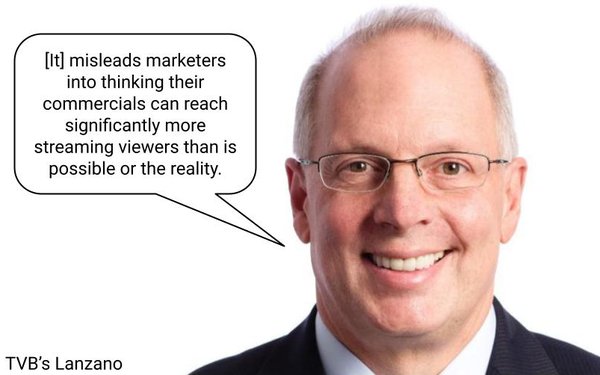
The Television Bureau of Advertising (TVB) is challenging a
new Nielsen tabulation aggregating total TV viewing across both linear and nonlinear viewing sources, because it includes some non-ad-supported viewing.
The new analysis, which Nielsen
released Tuesday as part of its monthly "The Gauge" newsletter, showed Disney has the biggest share of aggregate cross-platform audiences, followed by YouTube.
"The monthly Nielsen
Gauge and new Media Distributor Gauge reports provide an analysis of the content and programming that audiences are watching on television, including broadcast, cable, and streaming
platforms. However, these reports do not provide the key data needed by advertisers: Where do consumers see their commercials," the TVB said in a statement sent to the press.
TVB CEO and
President Steve Lanzano goes on to assert that distributor analysis "misleads marketers into thinking their commercials can reach significantly more streaming viewers than is possible or the
reality."
advertisement
advertisement
Nielsen's analysis never claimed the stat was representative of ad-supported viewing explicitly, and almost all of the streaming services aggregated in the distributor analysis have
some form of ad-supported option and that portion is growing fast among the major streaming services.
While it's unclear whether advertisers were confused by the new Nielsen analysis, Nielsen
has historically provided TV audience estimates for non-ad-supported platforms in the past, including premium subscription cable TV services, and public broadcasting TV stations too.
On
Monday, for example, Nielsen announced that PBS has received a grant from the Corporation for Public Broadcasting providing public TV stations with Nielsen's local audience data dashboards.
"The dashboards will display local market linear television audience data to give stations an enhanced understanding of the viewers they reach throughout the day," Nielsen said.
While
public TV stations do not explicitly sell advertising to brand marketers they commonly sell "enhanced underwriting" spots promoting brands that are a form of paid media akin to advertising, even if
they are not historically tied to audience estimates and guarantees.
“Nielsen’s unique capability to report PBS audiences across all platforms, including cable satellite,
over-the-air, digital & virtual MVPDs enables PBS member stations to demonstrate their engaged audiences to sponsors, underwriters, and community organizations," Nielsen Local TV Managing Director
Paul LeFort said in a statement.
That said, Nielsen's new media distributor aggregation has generated criticism from demand-side sources, as well, including a comment by Connelly Partners
Media Director Erin Mullaney on LinkedIn that includes a
link to a recent analysis she published on the agency's blog.
"While more
people have CTV devices, what percent of the population can you actually reach through CTV ads?," asks, going on to note: "Ad-supported reach is low given the top publishers have majority ad-free
viewership, with the exception of Prime Video, which just switched over to ad-supported in Q1. But Prime Video comes with your Amazon subscription, which gives the platform a larger reach but is less
of an intentional subscription like Hulu or Netflix. This comes into play when when you look at time spent. Time with Hulu is more than double the time spent with Prime Video."